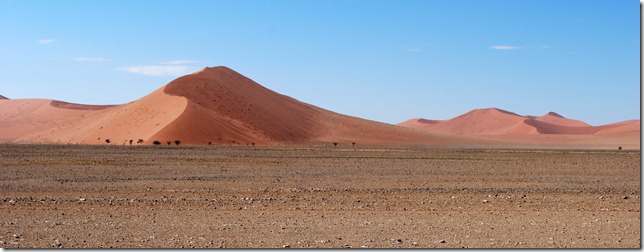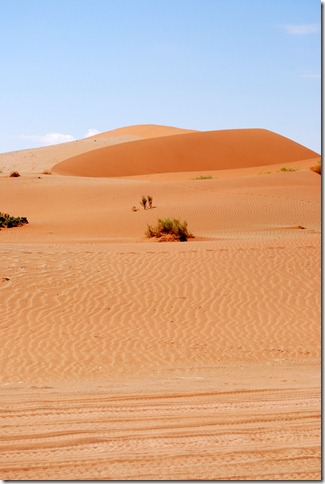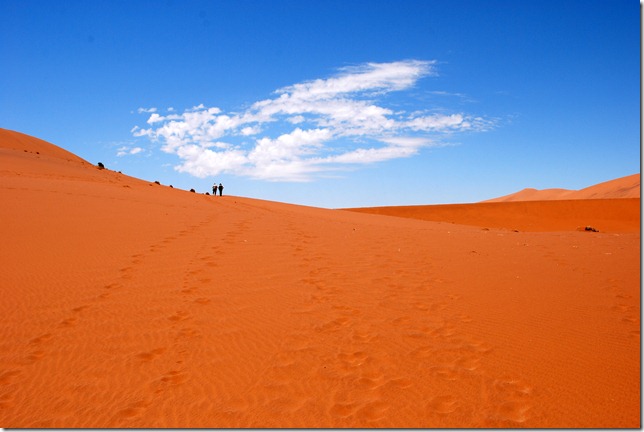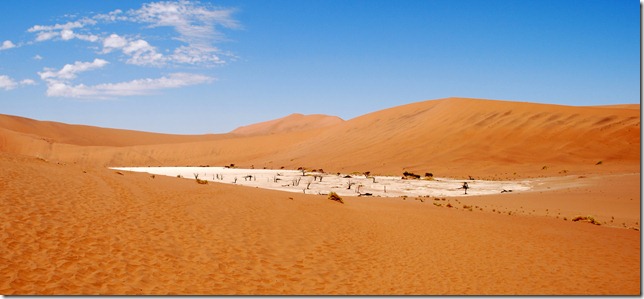We awoke on the morning of the 2nd at 5:30 in order to take full advantage of the day, but as the sun had not yet found its way over the mountains, we decided to rest a little more on the mattresses that Fritz had kindly lent us. The table and extra mattress that we had propped in front of the two doors of our concrete shelter had served us well in keeping out the creepy crawlers (e.g., scorpions!), and we slept reasonably well despite the heat and the occasional mozzie flying around our heads.
Around 6:00, I crawled off the mattress and began pouring charcoal into the braai in an attempt to heat some water for coffee. It took a little while, but eventually we had cups of Nescafe and Milo (a malt drink for Dallas) to accompany our cereal and powdered milk. Tracey emerged from the shelter with a plate on which were a few cookies topped with lit candles, and she and Dallas did a pretty good rendition of Happy Birthday for me as the morning sunlight reflected off the red dunes in the distance.
Packed and ready, it was time to head to the main attraction, Sossusvlei. This vast expanse of massive red sand dunes is Namibia’s 2nd most popular tourist attraction (the Etosha National Park being 1st), and I had wanted to see it ever since I saw the photos of the dunes in the brochures we picked up in Cape Town. After spending a day driving to see it, our plans were nearly thwarted as a result of rain the night before. As we approached the Sossusvlei Park, we came to an offshoot from the Tsauchab River that was running across the road with force. Fritz had told us that in these cases, one just has to wait for a couple of hours for the water to drop, but it seemed as though this one was going to take an entire day. (We later learned that the locals put a stick in the river to determine the rate at which the water is dropping.) Fortunately, we found another route and only had to cross the river-on-the-road twice when it was relatively shallow.
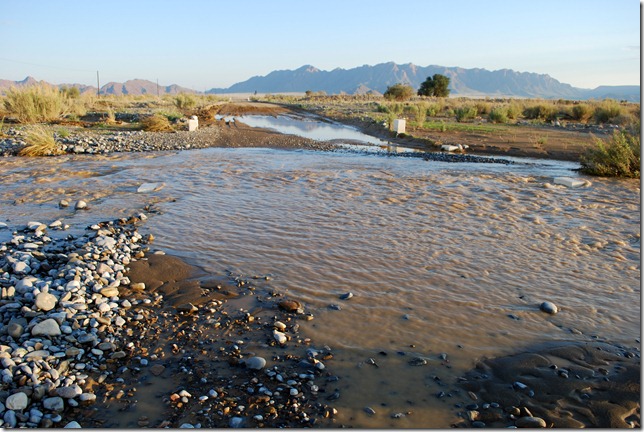 Not gonna get through this obstacle
Not gonna get through this obstacle
Once in the park, the views were astounding. Some of these dunes are over 1,000′ tall and are reported to be some of the highest in the world. Each dune has multiple crests that meet at the highest point and change shape as a result of the changing wind. The crests often form a large S running alongside the dune that is highlighted by the effects of the sun and shadows. This is but one of the visual effects that led to our impression of the place as a photographer’s dream.
Of course the most obvious and unique visual effect is the reddish hues of the dunes, ranging from salmon pink to burnt sienna to bright reddish orange depending on the sunlight and time of day. The redness is apparently the result of the higher levels of rainfall in the area relative to other parts of the desert. The rain feeds the Tsauchab River which once flowed to the sea but is now blocked by the dunes, creating a lake (“vlei”) during times of heavy rain. Over time, oxygen from the water has combined with iron in the sand, and voila! Rusty sand!
Most of the park can be viewed by car, but the last 4 kilometers before Sossusvlei itself (the lake bed) are unpaved and 4-wheel drive only. Despite the strange looks and reminders from the shuttle drivers that it was very hot (probably upper 80s), we decided to walk this bit. This gave us a chance to experience the quiet mystery of the place. Of course this also allowed us to take lots and lots of photos of the dunes as well as the various rippling effects in the sand created by the typically westerly winds.
We were lathered up with sunscreen (thanks for the 70 SPF, Santa), carried plenty of water, and were pretty comfortable during the walk with one notable exception — our feet! Note to self: when walking over two miles through the desert, flip flops may sound like a good idea, but closed-toe shoes are strongly advised! It wasn’t a big deal until we left the primary trail in search of “Deadvlei” (a permanently dried out lake bed). The markings for the path to the vlei were minimal, so we found ourselves just following in others’ potentially misguided footsteps through loose, burning sand up the side of a large dune. This is certainly an amazing experience that I could only have envisioned in reference to movies such as Star Wars or 10,000 B.C., but I must admit that at the time, I was a little preoccupied with my burning feet! I am generally pretty tolerant of pain, but this was intense, and there was no relief in sight……fortunately we were in the right place, and when we arrived at the summit of the dune, we were rewarded with a breathtaking view of the white-clay lake bed set off by the surrounding red dunes. The lake bed was empty with the exception of several dramatic looking, leafless camel-thorn trees that are said to be as much as 500 years old!
As we prepared to descend the dune, we stopped for a water break, and I couldn’t resist pouring a bit on my feet….ahhh, temporary relief! Of course this use of our drinking water was considered questionable by my traveling companions (“you know you’ve been in the desert too long when…”), but I assured them that they could have the rest of the water as I would be taking the shuttle back! It turned out that after 2+ hours, they, too, had had enough desert hiking, so after a quick look around Sossusvlei itself (not nearly as cool as Deadvlei when dried out), we headed back to our car in comfort.
One aside that I feel compelled to mention — there were several makeshift toilets set up where the cars were parked, and Dallas encouraged Tracey and I to have a look at the one designated for men. It was nothing more than an open-air tent with a row of 5 or 6 pipes coming out of the ground. I suppose that’s as practical it gets!
By 3:00, we had made our way to the park restaurant and ordered some much-needed refreshments. Shortly thereafter, the rain came. It was one of those short, intense downpours that I have experienced many times in the tropics, but it was a desert first. Not for the restaurant staff, though, as they quickly set into motion sweeping up indoor puddles and battening down the hatches.
Once we were fed and watered, we picked up a few provisions for the evening braai at the local gas station/grocery store and made a final stop at the Sesriem Canyon. Carved out by the Tsauchab River over several centuries, the narrow gorge is about 30 meters deep and is pretty impressive when standing on the edge.
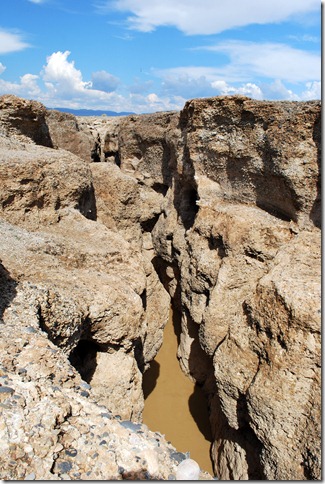 The canyon is 6 “ox-riems” (Afrikaans for ox-tails) deep
The canyon is 6 “ox-riems” (Afrikaans for ox-tails) deep
We returned to Fritz’s lodge for one last desert braai and sleep under the stars. After all of that time in the sun, I slept very well, “I promise you!” (common South African phrase). If someone would have suggested to me many years ago that I would be spending my 34th birthday in Namibia, having arrived there by sailboat, I probably would have been skeptical, but it was something I will never forget.


